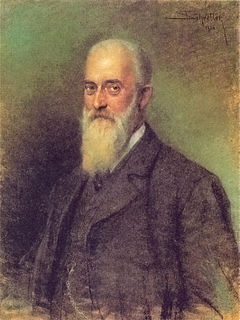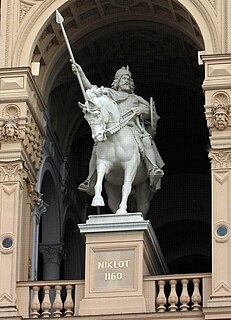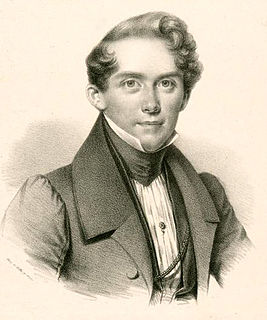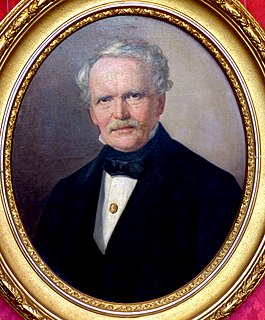
Mecklenburg is a historical region in northern Germany comprising the western and larger part of the federal-state Mecklenburg-Western Pomerania. The largest cities of the region are Rostock, Schwerin, Neubrandenburg, Wismar and Güstrow.

Schwerin Castle, is a schloss located in the city of Schwerin, the capital of Mecklenburg-Vorpommern state, Germany. It is situated on an island in the city's main lake, Lake Schwerin.

Theodor Martens was a 19th-century German artist.
Georg Christian Benedict Ackermann was a German theologian and teacher.

Mecklenburg Castle was a medieval castle and a residential capital of the Nakonid and Nikloting dynasties of the Obotrites. It was located just south of the modern village Dorf Mecklenburg, seven kilometres south of the Bay of Wismar in Mecklenburg-Vorpommern, Germany. The only remnants of the ruined castle are parts of an earthen wall. Some scholars have associated Mecklenburg with the medieval trading emporium Reric.
Heinrich Pommerencke (1821–1873) was a successful portrait painter of Mecklenburg-Schwerin.

Christopher, Duke of Mecklenburg-Gadebusch was a son of Albrecht VII, Duke of Mecklenburg. He was Duke of Mecklenburg-Gadebusch, as well as administrator of Ratzeburg and of the Commandery of Mirow.

Franz Wilhelm Johann Bunke was a German landscape painter.

Carl Wilhelm Christian Malchin was a German landscape painter and art conservator.

Otto Piper (1841–1921) was a German architectural historian who, with August von Cohausen (1812–1896), is regarded as one of the two founders of scientific research into castles.

Georg David Matthieu was a German engraver and portrait painter in the Rococo style who worked as court painter for the Duke of Mecklenburg.

Adolf Friedrich Wilhelm Wachenhusen was a German landscape artist, draftsman and etcher. The focus of his work was on the countryside of his home region, Mecklenburg.
Daniel Woge (1717-1797) was a German draughtsman and painter.

Hartwig Karl Friedrich Eggers was a German art historian. He was a member of the literary groups Tunnel über der Spree and Rütli.

Christian Friedrich Genschow was a German sculptor. Although best known for his works at the Schwerin Palace, most of his creations were in smaller formats, in the tradition of the Berliner Bildhauerschule.

Jacob Eduard Mantius was a German operatic tenor, composer and voice teacher.

Georg Adolph Demmler was a German architect, socialist and politician; originally with the German People's Party (DtVP), then the Socialist Worker's Party of Germany (SAP).

Johann Heinrich Suhrlandt was a court painter for Duke Frederick II, and Grand Duke Frederick Francis I, of Mecklenburg-Schwerin.

Wilhelmine Suhrlandt, née Skoglund was a German lithographer.

Carl Suhrlandt was a German painter. All of his works feature animals; mostly horses.


















